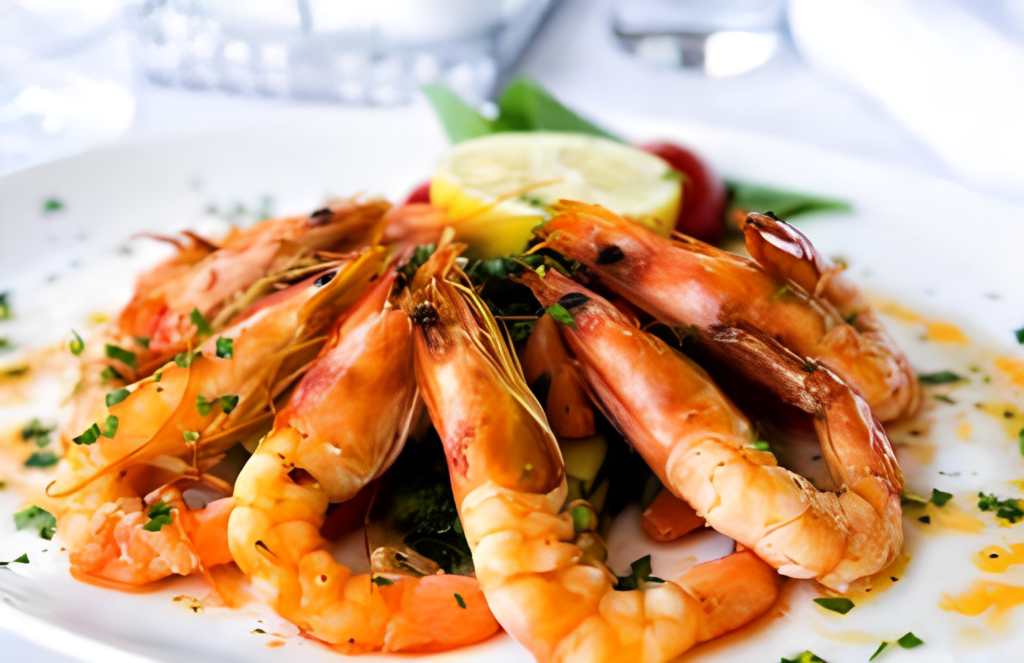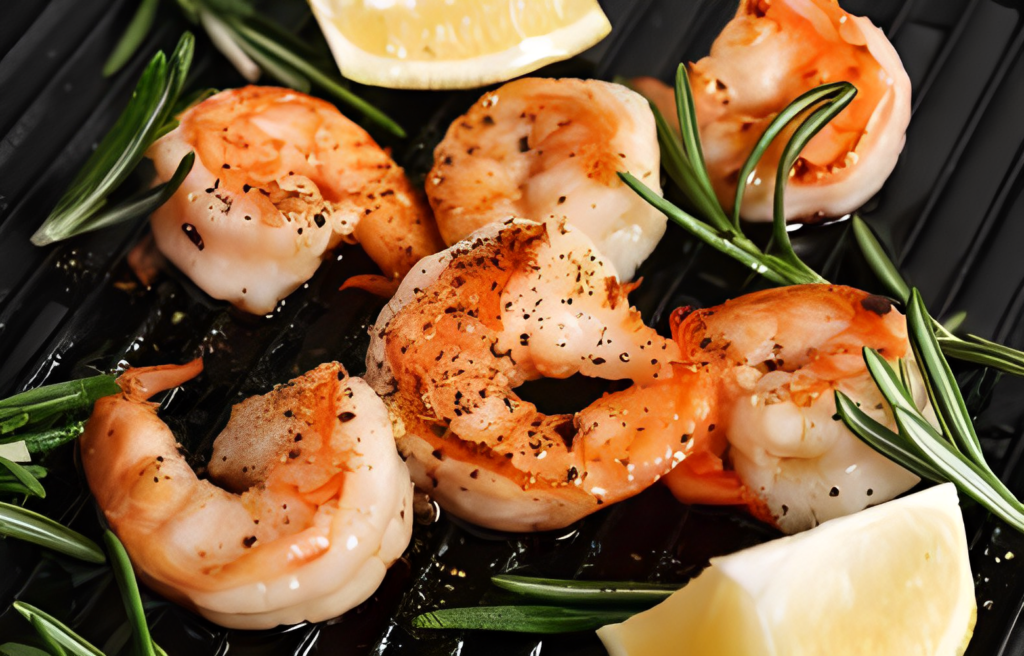
Introduction to Tiger Shrimp: A Culinary Delight
Discovering Tiger Shrimp
Tiger shrimp, a name that evokes curiosity and appetite, stands out in the seafood world. These crustaceans, known for their distinctive dark stripes, are a culinary favorite. They are not just any shrimp; they are the giants of the shrimp family. Often referred to as black tiger shrimp or giant tiger prawns, their presence in a dish promises a meaty and satisfying experience.
The Appeal of Tiger Shrimp
Why do we find ourselves drawn to tiger shrimp? The answer lies in their size and taste. Larger than their counterparts, they offer a more substantial bite. When cooked, their meat turns a pristine white, and the stripes become a vibrant red, making them not only delicious but visually appealing. This transformation is a feast for the eyes, enhancing the dining experience.
A Global Delicacy
Tiger shrimp have conquered markets worldwide, from Asia to Europe and America. Their popularity is not unfounded. Despite their exotic name, they share the familiar taste of regular shrimp but bring more to the table with their size and texture. This makes them a must-try for seafood lovers seeking something out of the ordinary.
Versatility in Cooking
One of the greatest strengths of tiger shrimp is their versatility. They can star in a variety of dishes, from stir-fries to grills. A simple stir fry, for example, can be a quick yet delicious way to enjoy them. Paired with fresh vegetables and a tangy sauce, tiger shrimp can transform a meal into a memorable experience. This adaptability makes them a valuable ingredient in the kitchen, capable of elevating a wide range of recipes.

Why We Love Tiger Shrimp
A Culinary Delight
Firstly, tiger shrimp captivate our palates with their unique flavor and texture. Unlike regular shrimp, these crustaceans offer a meatier bite. This makes them a preferred choice for various culinary applications. Moreover, their distinct stripes add an aesthetic appeal to dishes. This visual allure is not just for show; it signifies the shrimp’s freshness and quality.
Versatile in Cooking
Secondly, the versatility of tiger shrimp in cooking is unmatched. Whether grilled, sautéed, or incorporated into stir-fries, they adapt beautifully to different cuisines. This adaptability allows chefs and home cooks alike to experiment. As a result, shrimps have become a staple in both traditional and innovative recipes. Furthermore, their ability to absorb flavors enhances the overall taste of dishes.
A Sustainable Seafood Option
Lastly, sustainability plays a crucial role in our preference for tiger shrimp. Responsibly farmed and harvested shrimps contribute to environmental conservation. This aspect ensures that we can enjoy these delicious seafood items without depleting natural resources. Additionally, choosing sustainable options supports the livelihoods of those in the fishing industry. It’s a win-win situation for both our taste buds and the planet.
Ingredients Spotlight: Tiger Shrimp
The Star of the Show
At the heart of our culinary exploration is the tiger shrimp. This seafood delicacy stands out for its size and taste. It’s larger than most shrimp varieties. This size difference is not just for show. It means more succulent meat to enjoy in every bite. Additionally, the flavor of shrimps is rich and robust. It’s a taste that lingers pleasantly on the palate.
Complementary Ingredients
To elevate the tiger shrimp, we pair it with ingredients that enhance its natural flavors. Garlic, for instance, adds a pungent depth. It’s a match made in culinary heaven. Similarly, lemon brings a bright acidity. This balances the richness of the shrimp. Together, these ingredients create a harmonious blend of flavors.
Freshness is Key
The quality of the tiger shrimp is paramount. Fresh, or properly frozen, shrimp make all the difference. They ensure the dish’s success. Freshness translates to sweetness in the shrimp’s flesh. It also guarantees a firm texture. Thus, sourcing the best quality shrimps is crucial. It’s the foundation of a memorable dish.

Step-by-Step Cooking Guide: Tiger Shrimp
Preparing Your Ingredients
Firstly, gather all your ingredients. This includes fresh shrimps, garlic, lemon, and any herbs you prefer. Make sure the shrimp are cleaned and deveined. This step is crucial for ensuring the best texture and flavor. Additionally, chop your garlic finely and slice your lemon. These preparations set the stage for a seamless cooking experience.
Cooking the shrimps
Secondly, heat a pan over medium heat and add a touch of olive oil. Once hot, add the garlic. Let it sauté until fragrant. This infuses the oil with flavor. Next, add the shrimps to the pan. Cook them until they turn pink and opaque. This indicates they’re cooked perfectly. Remember, overcooking can make them tough.
Adding the Finishing Touches
Lastly, squeeze fresh lemon juice over the cooked shrimp. This adds a zesty brightness that elevates the dish. If you like, sprinkle chopped herbs over the top. This not only adds color but also freshness. Serve immediately to enjoy the full spectrum of flavors.
Nutritional Benefits
A Powerhouse of Nutrients
Tiger shrimp are not only delicious but also packed with nutritional benefits. Importantly, they are a great source of high-quality protein. This is essential for muscle building and repair. Additionally, they contain important vitamins and minerals. These include vitamin B12, selenium, and phosphorus. Each plays a crucial role in maintaining overall health.
Low in Calories, High in Omega-3s
Moreover, shrimps are low in calories. This makes them a great option for those monitoring their calorie intake. At the same time, they provide omega-3 fatty acids. These are beneficial for heart health. They help reduce inflammation and improve cardiovascular functions. Thus, incorporating shrimps into your diet can contribute to a healthy heart.
Boosting Immunity and More
Tiger shrimp also offer a boost to the immune system. This is thanks to their zinc content. Zinc is a mineral known for its immune-boosting properties. Furthermore, the antioxidants found in shrimps, such as astaxanthin, offer protection against free radicals. This can lead to improved skin health and a reduced risk of chronic diseases.
Serving Suggestions
Perfect Pairings
When it comes to serving shrimps, the possibilities are endless. A great way to start is by exploring recipes that highlight its versatility. For instance, the Shrimp Orzo Recipe on RecipesMaya.com offers a delightful combination. The orzo’s mild flavor and smooth texture complement the shrimp’s richness. This dish is not only satisfying but also visually appealing.
Enhancing Flavors
Additionally, consider serving tiger shrimp with sides that enhance its natural flavors. A simple yet elegant option is a side of grilled vegetables. Their smokiness pairs well with the shrimp’s sweetness. Moreover, a light, citrusy salad can add a refreshing contrast. These combinations ensure a balanced and enjoyable meal.
Creative Presentations
Finally, presentation matters. Serve your shrimps dishes in a way that showcases their beauty. Use garnishes like lemon wedges or fresh herbs. These not only add color but also hint at the flavors within the dish. A well-presented plate elevates the dining experience, making each bite more enjoyable.
Variations of the Recipe
Exploring New Flavors
When it comes to shrimps, the culinary adventure doesn’t stop at traditional recipes. In fact, experimenting with variations can lead to delightful discoveries. For instance, consider adding a spicy twist with a dash of chili flakes or cayenne pepper. This introduces a warmth that contrasts beautifully with the shrimp’s natural sweetness.
Fusion Cuisine Inspirations
Furthermore, fusion cuisine offers a treasure trove of ideas. Imagine combining the succulence of shrimps with flavors from around the world. A Thai-inspired version could include coconut milk and lemongrass, offering a creamy texture and a citrusy aroma. Alternatively, a Mediterranean twist with olives, tomatoes, and feta cheese brings out a savory richness that complements the shrimp perfectly.
Vegetarian Adaptations
Even vegetarians can enjoy variations of tiger shrimp recipes by substituting shrimp with plant-based alternatives. Ingredients like king oyster mushrooms or tofu can mimic the texture of shrimp. They absorb flavors well, making them suitable for the same marinades and sauces used in tiger shrimp recipes.
Conclusion
Celebrating Tiger Shrimp
In conclusion, tiger shrimp stand as a testament to the versatility and richness of seafood cuisine. From the simple joy of grilling to the complexity of fusion dishes, tiger shrimp adapt beautifully to a range of cooking styles and flavors. Their nutritional benefits add another layer of appeal, making them a smart choice for health-conscious food lovers.
A Call to Culinary Adventure
We encourage you to explore the vast possibilities that tiger shrimp offer. Whether you’re a seasoned chef or a curious home cook, there’s always something new to discover. By experimenting with different ingredients and techniques, you can unlock the full potential of this exquisite seafood. Let tiger shrimp be the star of your next culinary adventure, and enjoy the journey of taste and creativity it brings.
FAQs
Q: Can tiger shrimp be substituted in any shrimp recipe?
A: Absolutely! Tiger shrimp can be used in place of other shrimp varieties in most recipes. Their larger size and meatier texture may even enhance the dish.
Q: Are tiger shrimp sustainable?
A: Yes, when sourced responsibly. Look for certifications or labels that indicate sustainable farming or wild-catching practices to ensure you’re making an environmentally friendly choice.
Q: How do I know when tiger shrimp are cooked perfectly?
A: Tiger shrimp turn pink and opaque when fully cooked. It’s important not to overcook them to avoid a rubbery texture.